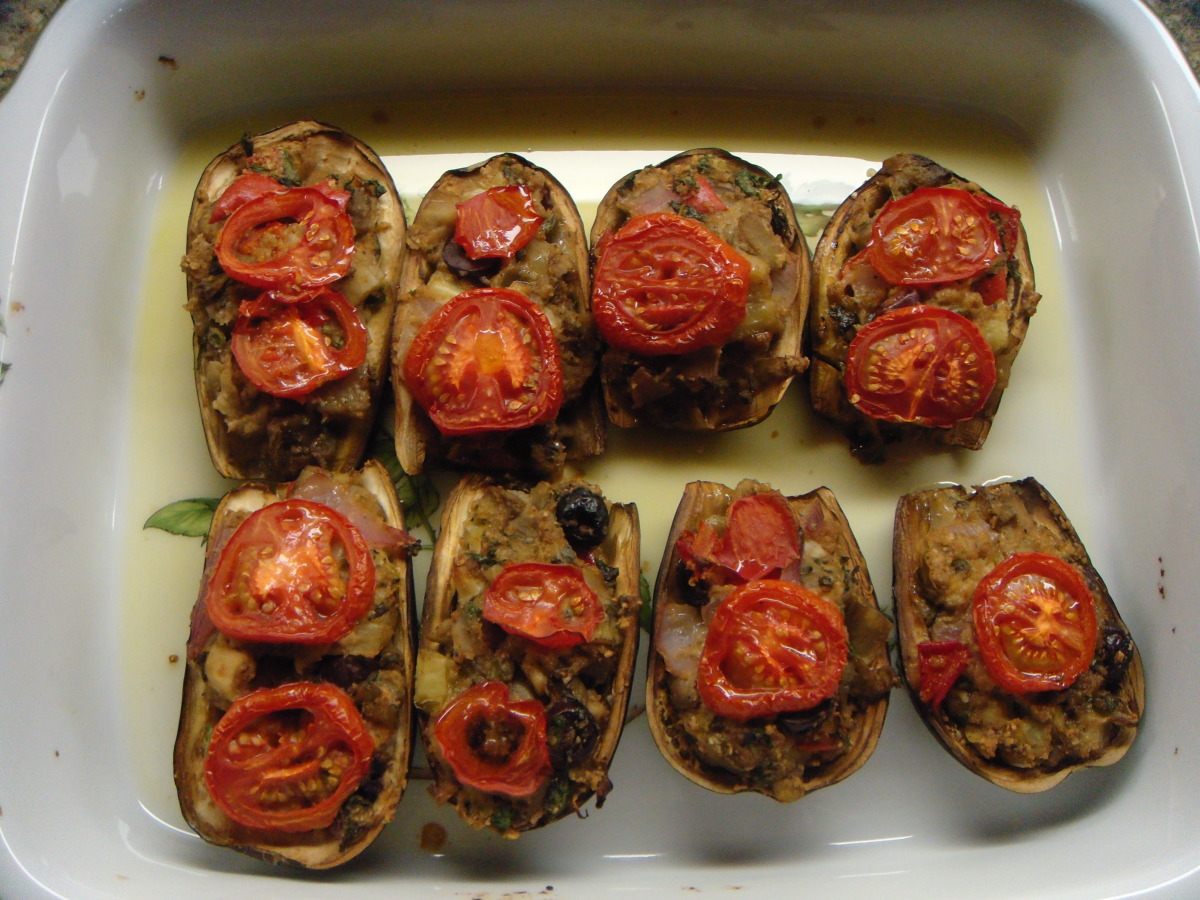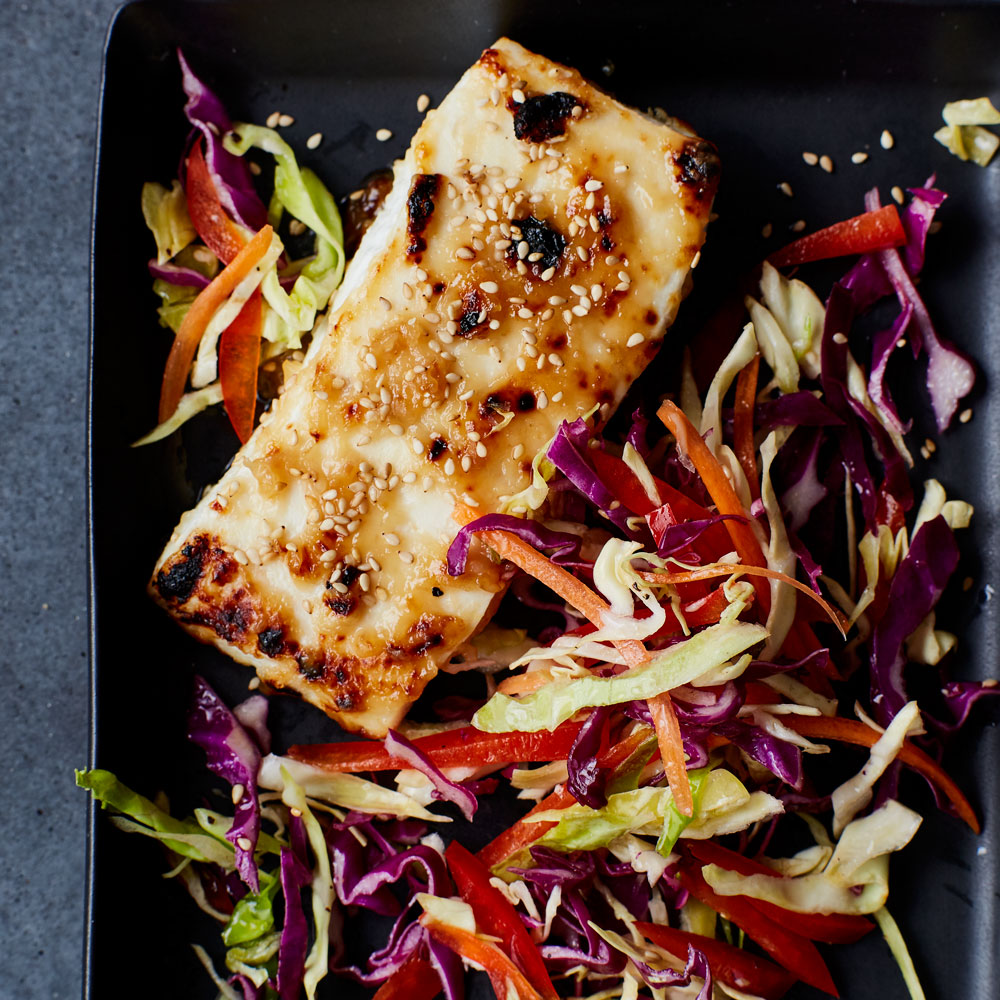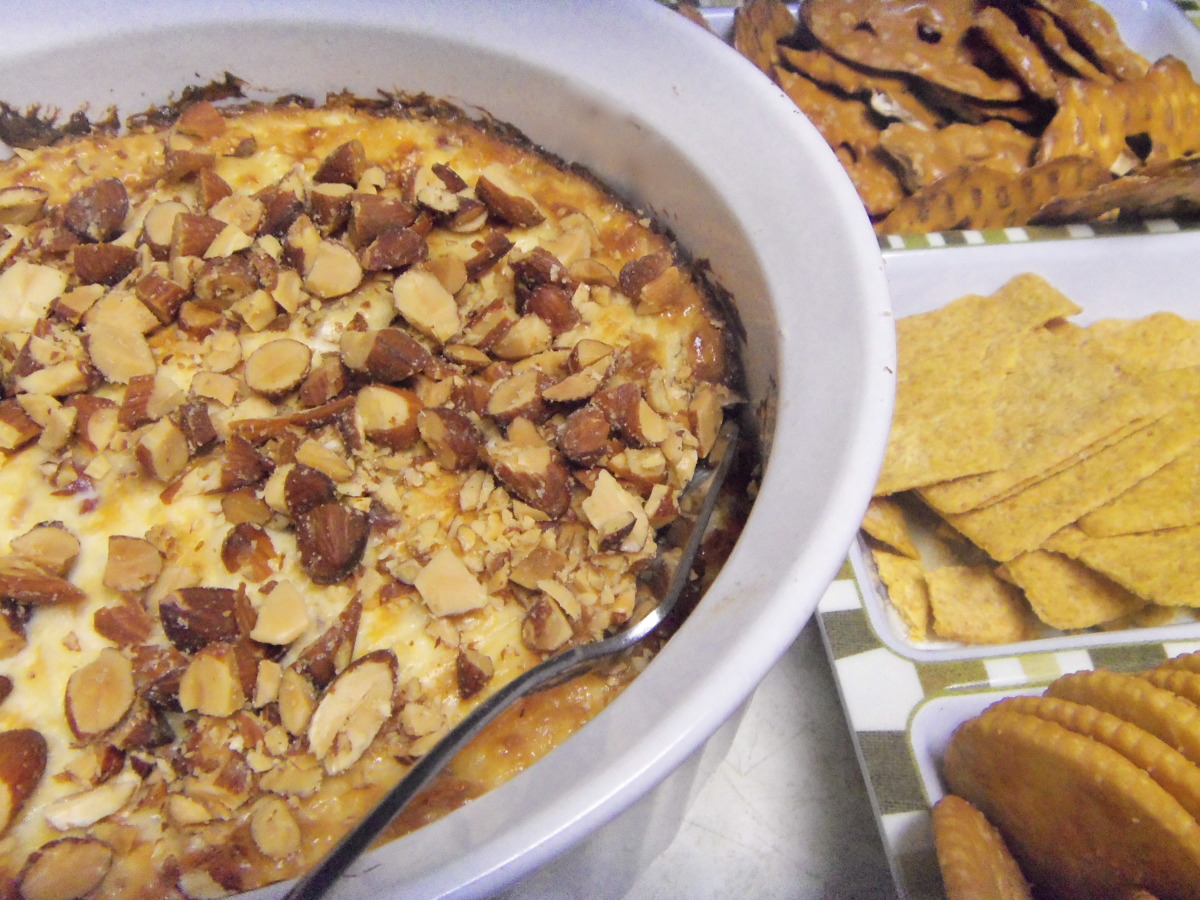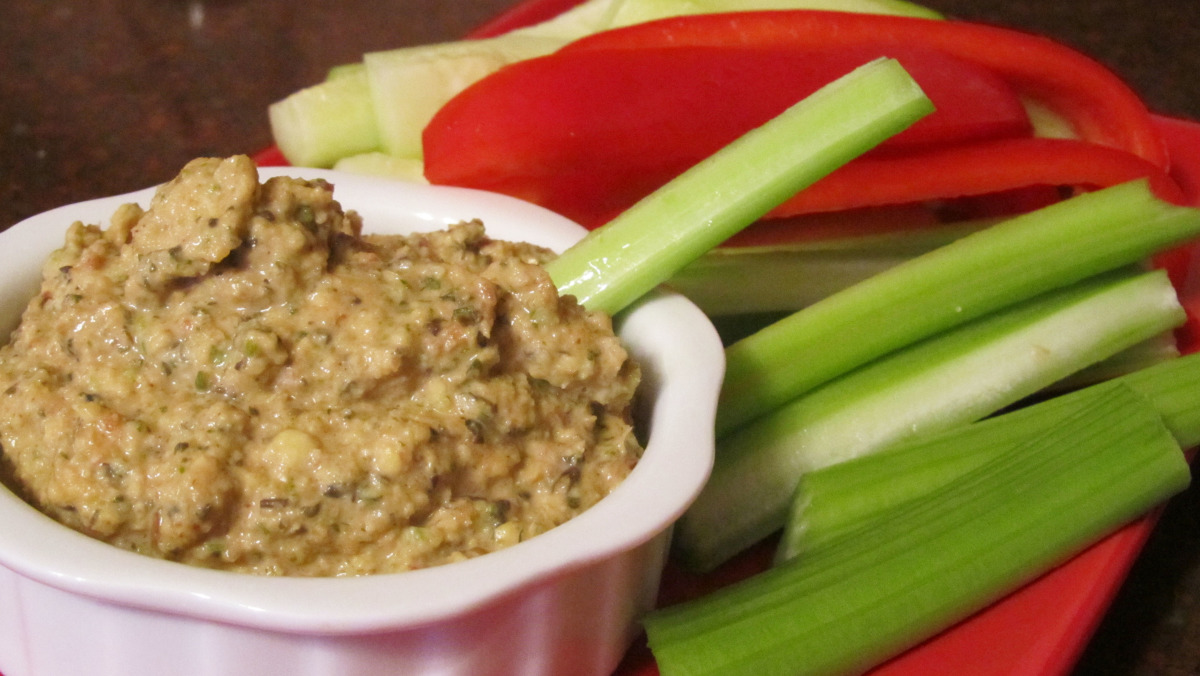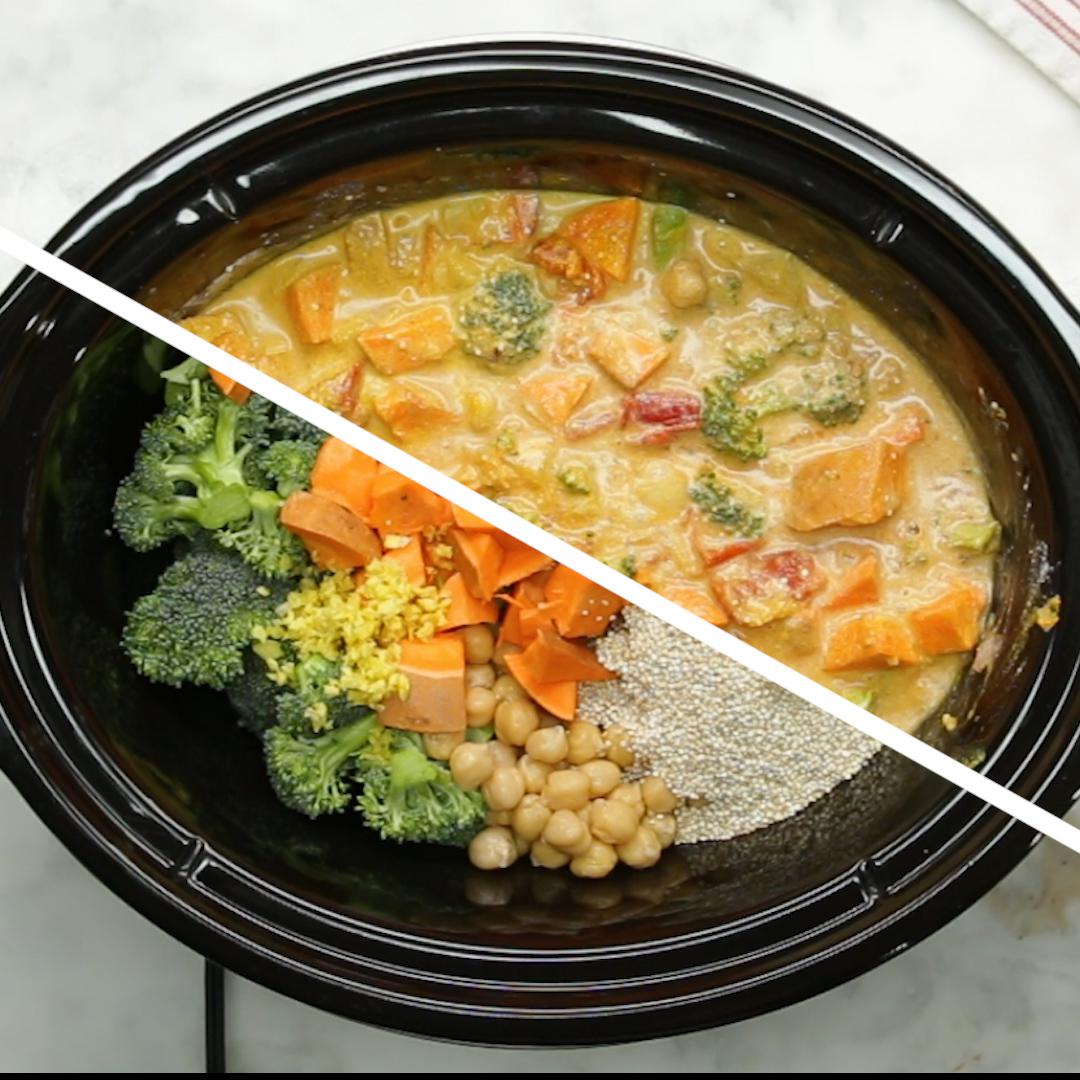**A flaky, buttery pastry that melts in your mouth, croissants are a French breakfast staple that has captivated taste buds worldwide. Our collection of croissant recipes offers a variety of options for making these delectable pastries at home, from traditional to modern and everything in between. With step-by-step instructions, detailed tips, and helpful videos, our recipes cater to bakers of all skill levels, ensuring a successful and enjoyable baking experience. From the classic croissant to pain au chocolat and savory variations, our recipes will guide you through the art of creating these iconic pastries, delighting your family and friends with every bite.**
Let's cook with our recipes!
CROISSANTS
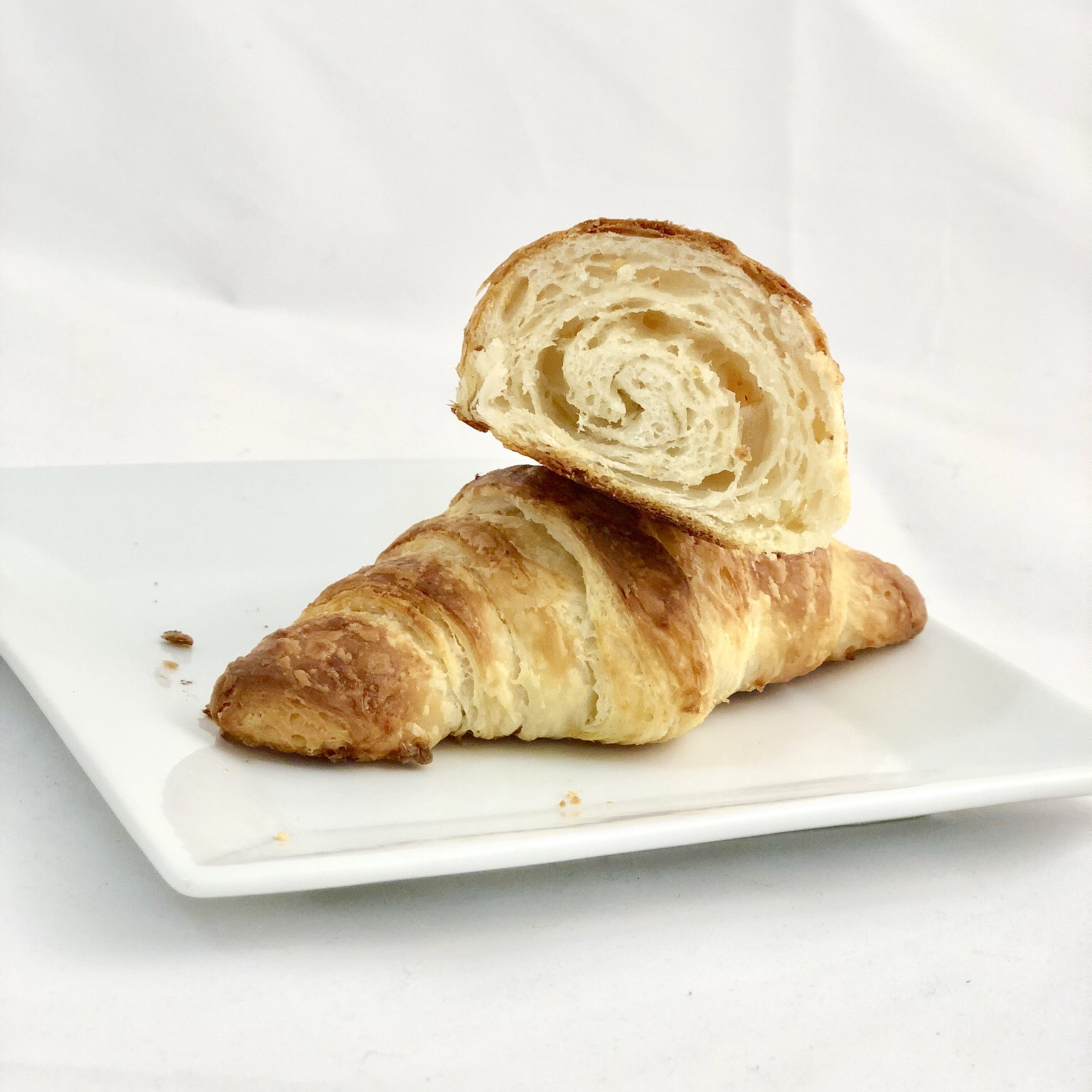
Authentic French croissants.
Provided by Kate
Categories Bread Yeast Bread Recipes
Time 11h15m
Yield 12
Number Of Ingredients 11
Steps:
- Combine yeast, warm water, and 1 teaspoon sugar. Allow to stand until creamy and frothy.
- Measure flour into a mixing bowl. Dissolve 2 teaspoons sugar and salt in warm milk. Blend into flour along with yeast and oil. Mix well; knead until smooth. Cover, and let rise until over triple in volume, about 3 hours. Deflate gently, and let rise again until doubled, about another 3 hours. Deflate and chill 20 minutes.
- Massage butter until pliable, but not soft and oily. Pat dough into a 14x8-inch rectangle. Smear butter over top two thirds, leaving 1/4-inch margin all around. Fold unbuttered third over middle third, and buttered top third down over that. Turn 90 degrees, so that folds are to left and right. Roll out to a 14x6-inch rectangle. Fold in three again. Sprinkle lightly with flour, and put dough in a plastic bag. Refrigerate 2 hours. Unwrap, sprinkle with flour, and deflate gently. Roll to a 14x6-inch rectangle, and fold again. Turn 90 degrees, and repeat. Wrap, and chill 2 hours.
- To shape, roll dough out to a 20x5-inch rectangle. Cut in half crosswise, and chill half while shaping the other half. Roll out to a 15 x 5 inch rectangle. Cut into three 5 x 5 inch squares. Cut each square in half diagonally. Roll each triangle lightly to elongate the point, and make it 7 inches long. Grab the other 2 points, and stretch them out slightly as you roll it up. Place on a baking sheet, curving slightly. Let shaped croissants rise until puffy and light. In a small bowl, beat together egg and 1 tablespoon water. Glaze croissants with egg wash.
- Bake in a preheated 475 degrees F (245 degrees C) oven for 12 to 15 minutes.
Nutrition Facts : Calories 195.5 calories, Carbohydrate 15.8 g, Cholesterol 45.9 mg, Fat 13.4 g, Fiber 0.6 g, Protein 3.1 g, SaturatedFat 7.1 g, Sodium 303.5 mg, Sugar 1.8 g
CROISSANTS
Follow our step-by-step croissant recipe to make a classic baked good worthy of a French pastry shop.
Provided by Martha Stewart
Categories Food & Cooking Breakfast & Brunch Recipes
Yield Makes about 20 croissants
Number Of Ingredients 11
Steps:
- Make the dough: Stir yeast, water, and 1 teaspoon sugar in a bowl. Let stand until foamy, about 5 minutes. Butter a large bowl; set aside. Put bread flour, all-purpose flour, remaining 3 tablespoons plus 2 teaspoons sugar, and the salt into the bowl of an electric mixer fitted with the dough hook; mix on low speed until combined. Add yeast mixture, milk, and butter; mix until dough just comes together.
- Knead dough: Scrape dough out onto a lightly floured work surface. Using lightly floured hands, knead until smooth, about 3 minutes. Transfer to buttered bowl, turning to coat.
- Let dough rise: Cover dough with plastic wrap; transfer to the refrigerator. Let rise until doubled in bulk, about 2 hours (dough should not spring back when you press it with your finger).
- Make the butter package: About 45 minutes after the dough begins rising, put flour and butter into the clean bowl of an electric mixer fitted with the paddle attachment. Mix on medium speed until well combined, 3 to 4 minutes. Scrape butter mixture out onto a piece of parchment paper; shape into a rectangle. Top with parchment, and roll out to an 8-by-10-inch rectangle. Transfer to a baking sheet, and refrigerate 30 minutes.
- Roll out dough: Turn out dough onto a lightly floured work surface; shape into a rectangle. Roll out to a 10 1/2-by-16-inch rectangle, about 1/2 inch thick, with short side facing you.
- Place butter package on dough: The butter package should be cool but pliable; your finger should leave an indentation but the butter should still hold its shape. If too soft, continue to refrigerate; if too firm, let stand at room temperature briefly. Place horizontally on bottom half of dough; remove parchment. Fold top half of dough over butter package, and pinch edges of dough to seal.
- Roll in butter: Turn dough so that a short side is facing you and the seam is on the right. Roll out to a 10-by-20-inch rectangle, about 1/2 inch thick (keep the corners as square as possible).
- Fold dough into thirds: Remove any excess flour with a pastry brush. Starting at the far end, fold rectangle in thirds as you would a business letter (this completes the first of 3 "turns").
- Mark dough: Mark the dough with your knuckle (later, this will help you remember how many turns have been completed). Wrap dough in plastic, and refrigerate 1 hour.
- Repeat process: Remove from refrigerator, and press the dough; it should be pliable but have some resistance. If too soft, return to refrigerator; if too firm, let stand at room temperature, 5 minutes. Repeat the preceding three steps to complete two more turns (make 2 marks for the second turn and 3 marks for the third turn); always start with a short side facing you and the seam on the right, rolling lengthwise before crosswise. After the second turn, wrap dough in plastic, and refrigerate 1 hour. After the third and final turn, wrap dough in plastic, and refrigerate 8 hours (or overnight).
- Roll out and chill dough: Turn out dough onto a lightly floured work surface, and roll out to a 30-by-16-inch rectangle. If dough becomes unmanageable, cut in half crosswise, and roll out two 15-by-16-inch rectangles (refrigerate 1 piece as you work with the other). Chill in freezer 15 minutes. Remove dough, and remeasure: It should match original dimensions; if not, roll out again. If dough becomes too warm or elastic, chill in freezer, 15 minutes.
- Cut dough: Cut dough into two 30-by-8-inch rectangles (or four 15-by-8-inch rectangles). Stack rectangles, lining up edges (if you have four smaller rectangles, make two stacks).
- Trim dough and cut into triangles: Using a pastry or pizza wheel and cutting at a 20-degree angle, trim a small wedge from one short side to create an angled side. Cut dough into triangles, each with a 4 1/2-inch base. You should have about 20 total.
- Cut slits: Cut a 1-inch slit in the middle of the base of each triangle. Separate the stacks, transferring half the triangles to a parchment-lined baking sheet; cover, and refrigerate.
- Begin shaping croissants: Working with one triangle at a time and keeping remaining triangles covered with a clean kitchen towel, hold the two corners of the base, and stretch to lengthen it slightly. Grasp inner corners formed by the slit in the base, and lift and stretch them toward the outer sides of the triangle; press to seal.
- Roll croissants: Using your fingertips, roll the base of the triangle up and away from you, stretching the dough slightly outward as you roll to elongate the point (when finished, the point should be tucked under the croissant).
- Finish shaping croissants: Bend the two ends toward you to form a crescent shape (the ends should almost touch). Transfer to parchment-lined baking sheets, spacing croissants 2 inches apart. Repeat with remaining triangles. Cover loosely with plastic wrap, and let stand in a warm place until croissants have doubled in bulk and are very soft, 1 1/2 hours to 2 1/4 hours, depending on the temperature of room.
- Brush with egg: Preheat oven to 400 degrees, with racks in upper and lower thirds. Brush tops of croissants with egg. Bake, rotating sheets halfway through, until croissants are puffed and golden brown, 20 to 25 minutes. Let cool slightly on sheets on wire racks. Serve warm or at room temperature.
TRADITIONAL LAYERED FRENCH CROISSANTS
Crisp buttery outer layers and a soft, delicate interior make these delectable croissants melt in your mouth.
Provided by moeagaru
Categories Bread Yeast Bread Recipes
Time P1DT6h45m
Yield 24
Number Of Ingredients 11
Steps:
- Sprinkle 2 tablespoons of flour over the butter and mix it together with your hands in a mixing bowl or on a work surface. Transfer the butter to a length of foil or parchment paper and pat it into a 6 inch square. Fold up the foil to make a packet and refrigerate until chilled, about 2 hours.
- Combine 2 cups of the flour with the salt and sugar in a mixing bowl. Dissolve the yeast in the lukewarm water (100 degrees F/38 degrees C) and set aside until frothy, about 10 minutes. Meanwhile, warm the milk and the heavy cream to lukewarm. Add the yeast, milk, and cream to the flour mixture and stir well. The dough will have a batter-like consistency.
- Stir in the remaining 2 cups of flour 1/4 cup at a time to form a soft dough. It should no longer be sticky. Turn the dough onto a lightly floured work surface and knead until smooth, about 5 minutes. Place the dough in a mixing bowl and cover with plastic wrap. Refrigerate for 1 hour.
- To begin the rolling and folding process, both the butter and the dough should be at a cool room temperature. [See Cook's Note.] Place the dough on a floured surface and roll it into a 10-inch square. Set the block of butter diagonally on the square dough. Bring each point of dough to the center of the butter square; the edges of the dough should overlap. Pinch the edges together to seal.
- Starting from the center of the square and working outward, use a rolling pin to roll the dough out into a rectangle. The butter should be pliable enough to roll smoothly with the dough; if it's too soft and starts to ooze out the corners, wrap the dough in plastic and refrigerate before proceeding. Roll the dough into a long rectangle, approximately 8 by 18 inches. Fold the length of dough into thirds, like a business letter.
- If the dough is still cool, you can continue with another fold. Otherwise, wrap it in plastic and refrigerate for 45 minutes to 1 hour. Remove the dough from the refrigerator and let it warm up for about 10 minutes before you begin rolling it out again.
- Position the dough so that the open ends are at 12 and 6 o'clock. Roll the dough into a rectangle, working from the center of the dough and pressing outwards. Reposition the dough as necessary to fit your work space. You should have a long rectangle for the "book fold." Fold both ends of the dough into the middle; the ends don't have to be touching, but should be close. Fold the already-folded dough in half; it will look like a thick book. Wrap the dough well with plastic and refrigerate for 1 to 2 hours.
- Remove the dough from the refrigerator and let it rest at room temperature for about 20 minutes. Roll the dough into a rectangle again and fold it into thirds, like a business letter. Wrap it in plastic and refrigerate for 4-6 hours or overnight.
- To shape the croissants, roll the dough into a 10- by 38-inch rectangle on a lightly floured work surface. It should be about 1/4 inch thick. Use a pizza wheel or sharp paring knife to trim the edges of the dough. Divide the rectangle in half so that you have two 5-inch wide strips of dough. Use a clean yardstick to mark each strip into triangles that are 5 inches wide at their bases. Cut the triangles and place them onto parchment-lined baking sheets. Chill for 15 to 20 minutes, if necessary.
- Starting at the base of the triangle, roll the dough up into a log; the tip of the triangle should be under the body of the croissant to prevent it from unraveling. Bend in the corners to form the traditional crescent shape. Repeat with the remaining dough.
- Arrange the croissants on the parchment-lined baking sheets and allow to rise until doubled in size, about 1 to 2 hours.
- Preheat an oven to 425 degrees F (220 degrees C). Beat the egg with the tablespoon of water to make the egg wash. Brush the croissants with egg wash and bake in the preheated oven until deep brown, 22 to 25 minutes. Cool on a rack before serving.
Nutrition Facts : Calories 212.5 calories, Carbohydrate 18.8 g, Cholesterol 44.9 mg, Fat 14 g, Fiber 0.7 g, Protein 3.2 g, SaturatedFat 8.7 g, Sodium 139.6 mg, Sugar 2.1 g
HOMEMADE CROISSANTS
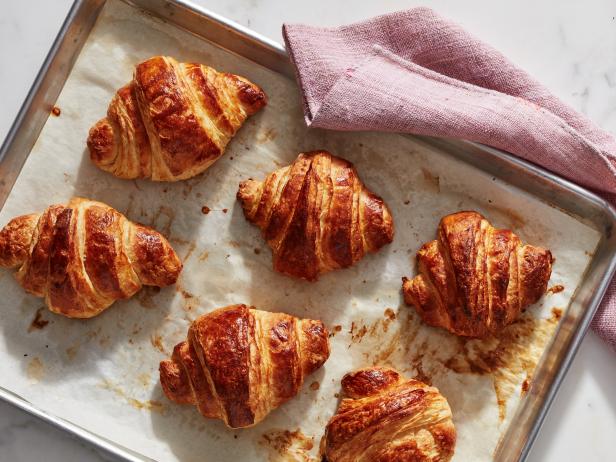
Rich, buttery and utterly delicious, these flaky croissants will undoubtedly impress anyone who's lucky enough to snag one. They do require a time commitment, but once you smell them freshly baked from the oven, you'll know it was worth every minute.
Provided by Food Network Kitchen
Time 18h40m
Yield 15 croissants
Number Of Ingredients 7
Steps:
- Combine the flour, milk, sugar, yeast, salt, 3 tablespoons room-temperature butter and 1/2 cup cold water in the bowl of a stand mixer fitted with the dough hook. Mix on low speed until the dough starts to come together, about 2 minutes. Increase the speed to medium and continue to mix until completely combined and gathered into a ball that is no longer sticky to the touch, about 5 minutes. Transfer the dough to a lightly floured baking sheet, dust the top with flour and wrap in plastic wrap. Refrigerate overnight.
- The following day, put the remaining cold butter pieces (2 1/2 sticks) in the middle of a piece of parchment and dust with a generous pinch of flour. Top with another piece of parchment. With a rolling pin, pound the butter to form a 7-inch square, using a bench scraper or ruler to help even out the sides. Refrigerate while you roll out the dough.
- To roll and fold the dough: Unwrap the dough and lay it on a lightly floured work surface. Roll into a 12-inch square, dusting with flour as needed. Peel the parchment off the butter square and position the butter in the middle of the dough. Fold the top flap of dough over the butter towards you, stretching it slightly so that it reaches just past the center of the butter. Repeat with the opposite flap so they overlap by a couple inches. Turn the dough so that one of the open ends is closest to you.
- Using the rolling pin, gently pound the dough so the butter is spread out evenly in the middle of the dough. Then, roll the dough to an 8-by-24-inch rectangle. Pick up one short end of the dough and fold it back over the dough, leaving one-third of the other end of dough exposed. Then fold the exposed dough over the folded side (like folding a letter). Put the dough back on the baking sheet, cover with plastic wrap and chill so the dough relaxes and the butter firms slightly, 20 to 30 minutes.
- Lay the dough on a lightly floured work surface folded-side down. Roll in the direction of the 2 open ends, until the dough is about an 8-by-24-inch rectangle. Fold the dough in thirds again like a letter, put back on the baking sheet, cover and chill for another 20 minutes.
- Give the dough a third rolling, then fold one side to the middle of the dough and fold the other side to meet it in the middle. Fold the dough in half so it resembles a book. Put the dough on the baking sheet and cover with plastic wrap, tucking the plastic under all sides. Refrigerate for 2 hours and up to overnight.
- To divide the dough: Unwrap the dough and lightly flour the top and bottom. Roll the dough into a 10-by-35-inch rectangle. Lay the dough in front of you so the long sides are horizontal. Position a ruler lengthwise along the bottom side of the dough (the side closest to you) and mark with a paring knife every 5 inches along the length of the dough. Move the ruler to the top side of the dough (the side farthest from you) and make a mark on the dough at 2 1/2 inches. Move the ruler to the 2 1/2-inch mark, then make marks every 5 inches along the length of the dough from that point.
- Using a pizza cutter or long sharp knife, make a diagonal cut from the bottom left corner to the first mark on the top edge (at 2 1/2 inches), then cut diagonally down from that mark to the first 5-inch mark on the bottom edge of the dough, to make a triangle. Continue cutting diagonally from bottom mark to top mark and back again to create 15 triangles total (2 will be from the ends and a little smaller but still useable).
- Line 2 baking sheets with parchment. Lay one triangle on the work surface with the short side closest to you. Gently pull to extend the tip at the top. With one hand on each side of the short end of the triangle, start to roll the dough away from you towards the pointed end. Press down on the dough with enough force to make the layers stick together. Arrange the croissant on one of the lined baking sheets with the tip of the dough on the bottom. Repeat with the remaining dough triangles.
- Whisk the egg with a splash of water in a small bowl until combined. Lightly brush some of the egg wash on each croissant. (Refrigerate the remaining egg wash for later.) Put the croissants in a warm spot to proof, until puffy looking and about 1 1/2 times larger, about 2 hours.
- Position oven racks in the upper and lower thirds of the oven and preheat to 425 degrees F.
- Brush the croissants again with the egg wash. Bake for 10 minutes, then rotate the sheets from front to back and top to bottom. Continue baking until dark golden, another 8 to 10 minutes. Let cool on the baking sheets on wire racks.
QUICK BUTTER CROISSANTS

Despite the title, this recipe takes several hours to prepare. Luckily, these fresh flaky croissants will be worth the wait!
Provided by MARCIAMOLINA
Categories Bread Yeast Bread Recipes
Time 7h5m
Yield 16
Number Of Ingredients 10
Steps:
- In a large bowl, dissolve yeast in warm water. Let stand until creamy, about 10 minutes. Stir in milk, salt, sugar, 1 egg, 1 cup flour and melted butter. Beat to make a smooth batter; set aside.
- In a large bowl, cut the one cup firm butter into remaining four cups flour until butter particles are the size of dried kidney beans. Pour the yeast batter over this and carefully turn the mixture over with a spatula to blend, just until all flour is moistened. Cover with plastic wrap and refrigerate until well chilled, at least 4 hours or up to four days.
- Turn dough out onto a floured surface; press into compact balls and knead about 6 turns to release air bubbles. Divide dough into four equal parts. Shape one at a time. Refrigerate the remaining dough.
- Roll one part of the dough on a floured board into a circle 17 inches in diameter. With a sharp knife or pizza cutter, cut the circle into eight equal pie-shaped wedges. Roll the wedges loosely toward the point. Shape each roll into a crescent and place on an ungreased baking sheet. Allow 1 1/2 inches space between each roll.
- Cover and let rise at room temperature until almost doubled in size. Approximately 2 hours. Meanwhile, preheat oven to 325 degrees F (165 degrees C).
- Brush croissants with beaten egg. Bake in preheated oven for 35 minutes, until golden.
Nutrition Facts : Calories 311.5 calories, Carbohydrate 35.4 g, Cholesterol 64.8 mg, Fat 16.3 g, Fiber 1.1 g, Protein 5.9 g, SaturatedFat 9.9 g, Sodium 342.9 mg, Sugar 5.5 g
CROISSANTS
Provided by Food Network
Time 1h29m
Yield 20 servings
Number Of Ingredients 9
Steps:
- In a mixer with a dough hook, place the yeast, flour, sugar, salt and the milk and mix for 2 minutes until a soft moist dough forms on the hook. If most of the flour isn't moistened with this quantity of milk, add more, a tablespoon at a time until it is moistened and smooth, using up to 4 tablespoons. Turn mixer on high and mix for another 4 minutes until very smooth and elastic.
- Turn the dough out of the bowl onto a floured board, cover with a damp tea towel and allow it to rest for 15 minutes to relax the gluten. Remove the towel and, using a French rolling pin, roll the dough into a 10 by 9-inch rectangle 5/8-inch thick. Wrap in plastic then chill for 1 hour and up to overnight.
- Ten minutes before the dough is done resting in the refrigerator, prepare the butter. Beat it with your rolling pin on a floured surface to soften it and form a rectangle 6 by 8 1/2 inches. Place it between parchment paper or plastic wrap and set aside.
- Remove the dough from the refrigerator and roll it on a floured work surface into a 10 by 15-inch and 1/4-inch thick rectangle. Brush any excess flour off the dough. Place the shorter side of the dough parallel to the front of your body on the work surface. Place the butter in the middle, long-ways. Fold the bottom up over the butter and brush off any excess flour and then fold the top down over the butter to overlap and encase the butter. Press down lightly with the rolling pin to push all the layers together and make sure they have contact.
- Continue rolling the laminated (layered) dough to form a new 10 by15-inch rectangle, patching any holes with a dusting of flour where butter may have popped through. Fold into thirds, like a letter, brush off any excess flour and mark it with an indentation made by poking your finger once at the corner of the dough meaning you have completed the first "turn".
- Wrap well in plastic and chill 1 hour and up to overnight. Do this again three more times (some people only do 3 turns total, some do 6, some do 3 plus what's called a "wallet" turn for the last one which is a 4 fold turn that's folded into itself like a book jacket) marking it accordingly each time and chilling in between each turn.
- After the fourth turn, you can let the dough chill overnight, or, for 1 hour, or, roll it out to a 13 by 24-inch square that is a little less than 1/4-inch thick and cut out your croissants and shape them.
- I roll out my dough and cut it with a sharp large knife into 6-inch strips then cut them into triangles, 4 inches wide at the base of the triangle (or for a more curved croissant cut the triangles 6 inches wide). Stretch these triangles again 9 inches long, then place on the work surface and put a piece of scrap dough in the center of the wide end to enclose, which will plump up the center. Roll the triangles up towards you starting at the wide end and place them 2 inches apart on a parchment lined sheet pan with the tip tucked under and the ends slightly curved in to make a crescent shape. You may freeze the croissants at this point, or, in a small bowl, whisk together the egg and milk and brush the croissants with this egg wash.
- To proof the croissants, place them in an oven that is warm but not turned on, with a pan of hot water in the bottom to create a moist environment like a proof box. Set aside to proof for 1 1/2 to 2 1/2 hours until puffed up and spongy to the touch. Remove from the oven.
- Spritz a preheated 425 degree F oven with water, close the door, and get the croissants. Place the croissants in the oven and spritz again, close the door and turn the oven down to 400 degrees F. After 10 minutes, rotate your pan if they are cooking unevenly and turn the oven down to 375 degrees F. Bake another 5 to 8 minutes until golden brown.
CROISSANTS

This recipe is a detailed roadmap to making bakery-quality light, flaky croissants in your own kitchen. With a pastry as technical as croissants, some aspects of the process - gauging the butter temperature, learning how much pressure to apply to the dough while rolling - become easier with experience. If you stick to this script, buttery homemade croissants are squarely within your reach. (Make sure your first attempt at croissants is a successful one, with these tips, and Claire Saffitz's step-by-step video on YouTube.)
Provided by Claire Saffitz
Categories breakfast, brunch, pastries, project
Time P1D
Yield 8 croissants
Number Of Ingredients 11
Steps:
- Twenty-four hours before serving, start the détrempe: In the bowl of a stand mixer fitted with the dough hook, combine the flour, sugar, salt and yeast, and stir to combine. Create a well in the center, and pour in the water and milk. Mix on low speed until a tight, smooth dough comes together around the hook, about 5 minutes. Remove the hook and cover the bowl with a damp towel. Set aside for 10 minutes.
- Reattach the dough hook and turn the mixer on medium-low speed. Add the butter pieces all at once and continue to mix, scraping down the bowl and hook once or twice, until the dough has formed a very smooth, stretchy ball that is not the least bit sticky, 8 to 10 minutes.
- Form the dough into a ball and place seam-side down on a lightly floured work surface. Using a sharp knife, cut two deep perpendicular slashes in the dough, forming a "+." (This will help the dough expand into a square shape as it rises, making it easier to roll out later.) Place the dough slashed-side up inside the same mixing bowl, cover with plastic wrap and let rise at room temperature until about 1 1/2 times its original size, 45 minutes to 1 hour. Transfer the bowl to the refrigerator and chill for at least 4 hours and up to 12.
- As the dough chills, make the butter block: Place the sticks of butter side-by-side in the center of a large sheet of parchment paper, then loosely fold all four sides of the parchment over the butter to form a packet. Turn the packet over and use a rolling pin to lightly beat the cold butter into a flat scant 1/2-inch-thick layer, fusing the sticks and making it pliable. (Don't worry about the shape at this point.) The parchment may tear. Turn over the packet and unwrap, replacing the parchment with a new sheet if needed. Fold the parchment paper over the butter again, this time making neat, clean folds at right angles (like you're wrapping a present), forming an 8-inch square. Turn the packet over again and roll the pin across the packet, further flattening the butter into a thin layer that fills the entire packet while forcing out any air pockets. The goal is a level and straight-edged square of butter. Transfer the butter block to the refrigerator.
- Eighteen hours before serving, remove the dough from the refrigerator, uncover and transfer to a clean work surface. (It will have doubled in size.) Deflate the dough with the heel of your hand. Using the four points that formed where you slashed the dough, stretch the dough outward and flatten into a rough square measuring no more than 8 inches on one side.
- Place 2 pieces of plastic wrap on the work surface perpendicular to each other, and place the dough on top. Wrap the dough rectangle, maintaining the squared-off edges, then roll your pin over top as you did for the butter, forcing the dough to fill in the plastic and form an 8-inch square with straight sides and right angles. Freeze for 20 minutes.
- Remove the butter from the refrigerator and the dough from the freezer. Set aside the butter. Unwrap the dough (save the plastic, as you'll use it again) and place on a lightly floured surface. Roll the dough, dusting with flour if necessary, until 16 inches long, maintaining a width of 8 inches (barely wider than the butter block). With a pastry brush, brush off any flour from the surface of the dough and make sure none sticks to the surface.
- You're going to enclose the butter block in the dough and roll them out together. To ensure they do so evenly, they should have the same firmness, with the dough being slightly colder than the butter. The butter should be chilled but able to bend without breaking. If it feels stiff or brittle, let sit at room temperature for a few minutes. Unwrap the butter just so the top is exposed, then use the parchment paper to carefully invert the block in the center of the dough rectangle, ensuring all sides are parallel. Press the butter gently into the dough and peel off the parchment paper. You should have a block of butter with overhanging dough on two opposite sides and a thin border of dough along the other two.
- Grasp the overhanging dough on one side and bring it over the butter toward the center, then repeat with the other side of the dough, enclosing the butter. You don't need the dough to overlap, but you want the two sides to meet, so stretch it if necessary, and pinch the dough together along all seams so no butter peeks out anywhere. Lift the whole block and dust a bit of flour underneath, then rotate the dough 90 degrees, so the center seam is oriented vertically.
- Orient the rolling pin perpendicular to the seam and lightly beat the dough all along the surface to lengthen and flatten. Roll out the dough lengthwise along the seam into a 24-inch-long, 1/4-inch-thick narrow slab, lightly dusting underneath and over top with more flour as needed to prevent sticking. Rather than applying pressure downward, try to push the dough toward and away from you with the pin, which will help maintain even layers of dough and butter. Remember to periodically lift the dough and make sure it's not sticking to the surface, and try your best to maintain straight, parallel sides. (It's OK if the shorter sides round a bit - you're going to trim them.)
- Use a wheel cutter or long, sharp knife to trim the shorter ends, removing excess dough where the butter doesn't fully extend and squaring off the corners for a very straight-edged, even rectangle of dough. Maintaining the rectangular shape, especially at this stage, will lead to the most consistent and even lamination. If at any point in the process you see air bubbles in the dough while rolling, pierce them with a cake tester or the tip of a paring knife to deflate and proceed.
- Dust any flour off the dough's surface. Grasp the short side of the rectangle farther from you and fold it toward the midline of the dough slab, aligning the sides. Press gently so the dough adheres to itself. Repeat with the other side of the dough, leaving an 1/8-inch gap where the ends meet in the middle. Now, fold the entire slab in half crosswise along the gap in the center. You should now have a rectangular packet of dough, called a "book," that's four layers thick. This is a "double turn," and it has now quadrupled the number of layers of butter inside the dough.
- Wrap the book tightly in the reserved plastic. If it is thicker than about 1 1/2 inches, or if it's lost some of its rectangularity, roll over the plastic-wrapped dough to flatten it and reshape it. Freeze the book for 15 minutes, then refrigerate for 1 hour.
- Let the dough sit at room temperature for about 5 minutes. Unwrap and place on a lightly floured surface. Beat the dough and roll out as before (Step 10) into another long, narrow 3/8-inch-thick slab. It should be nice and relaxed, and extend easily. Dust off any excess flour.
- Fold the dough in thirds like a letter, bringing the top third of the slab down and over the center third, then the bottom third up and over. This is a "simple turn," tripling the layers. Press gently so the layers adhere. Wrap tightly in plastic again and freeze for 15 minutes, then refrigerate for 1 hour.
- Let the dough sit at room temperature for about 5 minutes, then unwrap and place on a lightly floured surface. Beat the dough and roll out as before, but into a 14-by-17-inch slab (15-by-16-inch for pain au chocolat or ham and cheese croissants). The dough will start to spring back, but try to get it as close to those dimensions as possible. Brush off any excess flour, wrap tightly in plastic, and slide onto a baking sheet or cutting board. Freeze for 20 minutes, then chill overnight (8 to 12 hours). If making pain au chocolat or ham and cheese croissants, see recipes.
- Four and a half hours before serving, arrange racks in the upper and lower thirds of the oven. Bring a skillet of water to a simmer over medium-high heat. Transfer the skillet to the floor of the oven and close the door. (The steam released inside the oven will create an ideal proofing environment.)
- As the steam releases in the oven, line two rimmed baking sheets with parchment paper and set aside. Let the dough sit at room temperature for about 5 minutes. Unwrap (save the plastic for proofing), place on a very lightly floured surface, and, if necessary, roll out to 17-by-14 inches. Very thoroughly dust off any excess flour with a pastry brush. Use a wheel cutter or long knife and ruler to cut the shorter sides, trimming any irregular edges where not all the layers of dough fully extend and creating a rectangle that's exactly 16 inches long, then cut into four 4-by-14-inch rectangles.
- Separate the rectangles, then use the ruler and wheel cutter to slice a straight line from opposite corners of one rectangle to form two long, equal triangles. Repeat with the remaining rectangles to make 8 triangles. Trim the short side of each triangle at a slight angle, making them into triangles with longer sides of equal length.
- Working one triangle at a time, grasp the two corners of the shorter end, the base of the crescent, and tug gently outward to extend the points and widen the base to about 3 inches. Then, gently tug outward from about halfway down the triangle all the way to the point, to both lengthen the triangle and thin the dough as it narrows. Starting at the base (the short end), snugly roll up the dough, keeping the point centered and applying light pressure. Try not to roll tightly or stretch the dough around itself. Place the crescent on one of the parchment-lined baking sheets, resting it on the point of the triangle. If the dough gets too soft while you're working, cover the triangles and freeze for a few minutes before resuming rolling. Space them evenly on the baking sheets, four per sheet. Very loosely cover the baking sheets with plastic wrap, so the croissants have some room to expand.
- Three and a half hours before serving, open the oven and stick your hand inside: It should be humid but not hot, as the water in the skillet will have cooled. You want the croissants to proof at 70 to 75 degrees. (Any hotter and the butter will start to melt, leading to a denser croissant.) Place the baking sheets inside the oven and let the croissants proof until they're about doubled in size, extremely puffy, and jiggle delicately when the baking sheet is gently shaken, 2 to 2 1/2 hours. Resist the urge to touch or poke the croissants as they proof: They're very delicate. Try not to rush this process, either, as an underproofed croissant will not be as light and ethereal.
- Remove the baking sheets from the oven and carefully uncover them, then transfer to the refrigerator and chill for 20 minutes while you heat the oven. Remove the skillet from the oven and heat to 375 degrees.
- In a small bowl, stir the yolk and heavy cream until streak-free. Using a pastry brush, gently brush the smooth surfaces of each crescent with the yolk and cream mixture, doing your best to avoid the cut sides with exposed layers of dough.
- Transfer the sheets to the oven and bake for 20 minutes. Rotate the baking sheets and switch racks, and continue to bake until the croissants are deeply browned, another 10 to 15 minutes. Remove from the oven and let cool completely on the baking sheets.
CHEF JOHN'S CHOCOLATE CROISSANTS
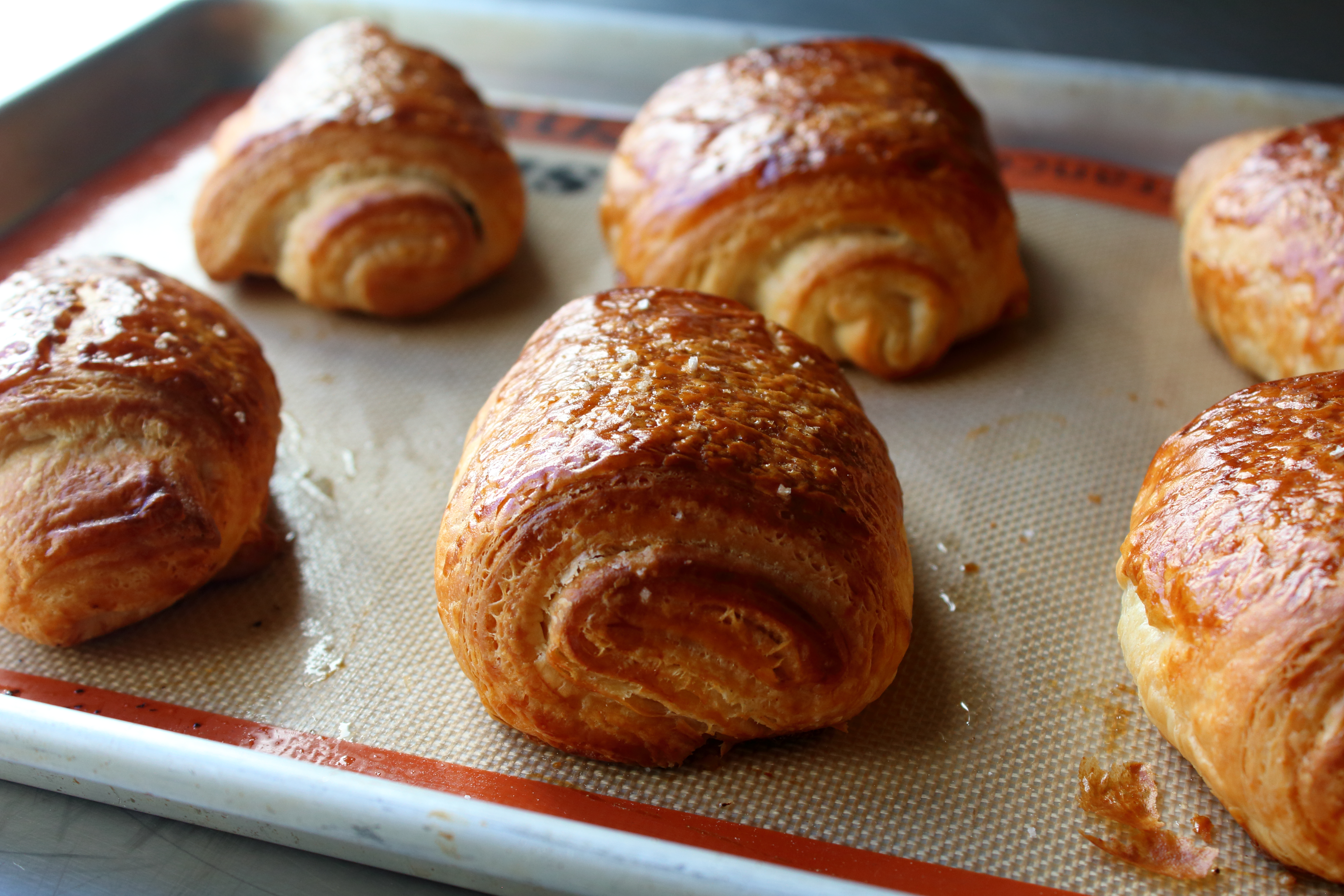
Making your own chocolate croissants takes a while, but for these crispy-on-the-outside, tender-on-the-inside pastries, it's time well spent. This recipe was adapted from one by Bruno Albouze, from The Real Deal (which he is). This is actually the quick version in that we're not leaving the dough to rest overnight before laminating with the butter.
Provided by Chef John
Categories Bread Yeast Bread Recipes
Time 5h55m
Yield 6
Number Of Ingredients 11
Steps:
- Place warm water in the bowl of a stand mixer. Sprinkle with yeast. Let yeast dissolve for 10 minutes. Add sugar and bread flour. Sprinkle with salt; add 3 tablespoons butter. Attach the bowl to the stand mixer. Mix dough with the dough hook just until butter is completely kneaded in and the dough forms a ball and pulls away cleanly from the sides of the bowl, 3 or 4 minutes.
- Transfer dough to a work surface and form into a semi-smooth ball. Place dough back in the mixer bowl; cover. Let rise in a warm spot until doubled, about 2 hours.
- Transfer dough to a lightly floured work surface. Push and press dough to deflate it, and form it into a rectangle. Fold into thirds by lifting one end over the middle third, and folding the other side onto the middle. Wrap in plastic wrap. Place on a rimmed baking sheet lined with a silicone mat. Refrigerate until chilled through, about 1 hour.
- Cut 1 stick of butter in 1/2 lengthwise and place halves slightly apart from each other on a length of parchment paper long enough to fold over the butter. Fold the parchment paper over the butter. Press butter down. Roll out with a rolling pin to a square about 8x8 inches. Refrigerate until a little chilled and just barely flexible, 10 or 15 minutes.
- Roll dough out into a rectangle slightly wider than the butter slab and just over twice as long. Place butter on one half of the dough leaving about 1 inch margin from the edge of the dough. Fold the other half of the dough over the butter. Dust work surface and dough with flour as needed.
- Press rolling pin down on dough to create ridges. Then roll out the ridges. Repeat this process. Keep pressing and rolling until dough is about the same size rectangle as you had before you folded it in half, dusting with just a bit of flour as necessary.
- Starting from the short side, fold one-third of dough over middle third. Then fold the other end over to form a small rectangle. Flatten out just slightly with rolling pin. Transfer to the silicone-lined baking sheet; cover with plastic wrap. Refrigerate until chilled, about 30 minutes.
- Transfer dough back to work surface and repeat pressing and rolling technique until dough is the size of the previous larger rectangle. Fold into thirds again, starting from the short side. Press and roll slightly. Transfer back to lined baking sheet. Cover and refrigerate about 15 minutes.
- Roll back out to a large rectangle. This time, fold dough in half. Then press and roll out into a 1/2-inch thick rectangle, using as little flour as needed to keep dough from sticking.
- Dust dough with flour and roll out to a rectangle about 1/8-inch thick. Cut dough lengthwise into 6 pieces using a pastry wheel.
- Pull and stretch out 1 of the dough pieces until ends are slightly tapered. Line 1 to 2 tablespoon of chocolate 1 inch parallel to the bottom edge and an equal amount of chocolate 1 more inch ahead. Roll dough up over the chocolate toward the top short edge to form a croissant with the seam at the bottom. Repeat with the remaining 5 dough pieces.
- Place shaped croissants on baking sheets lined with silicone mats. Whisk together egg and 1 tablespoon water to make the egg wash. Brush croissants with a large portion of the egg wash. Place in a warm area to allow them to rise, 60 to 90 minutes.
- Preheat oven to 400 degrees F (200 degrees C). Brush croissants gently but thoroughly again with egg wash. Sprinkle sea salt on top.
- Bake in preheated oven until beautifully browned, about 25 minutes. Transfer to a cooling rack. Cool to room temperature, about 1 hour.
Nutrition Facts : Calories 566.1 calories, Carbohydrate 52.7 g, Cholesterol 88.6 mg, Fat 36 g, Fiber 4.1 g, Protein 8.4 g, SaturatedFat 22 g, Sodium 591.7 mg, Sugar 22.4 g
BUTTERY CROISSANTS

A traditional dinner roll like this is always welcome at holiday dinners. This croissant recipe makes a big batch, so it's great when you're entertaining.
Provided by Taste of Home
Time 1h15m
Yield about 3 dozen.
Number Of Ingredients 10
Steps:
- In a small bowl, beat butter and flour until combined; spread into a 12x6-in. rectangle on a piece of waxed paper. Cover with another piece of waxed paper; refrigerate for at least 1 hour., In a large bowl, dissolve yeast in warm water. Add the milk, sugar, egg, salt and 2 cups flour; beat until smooth. Stir in enough remaining flour to form a soft dough. Turn onto a floured surface; knead until smooth and elastic, about 6-8 minutes. , Roll dough into a 14-in. square. Remove top sheet of waxed paper from butter; invert onto half of dough. Remove waxed paper. Fold dough over butter; seal edges. , Roll into a 20x12-in. rectangle. Fold into thirds. Repeat rolling and folding twice. (If butter softens, chill after folding.) Wrap in plastic; refrigerate overnight., Unwrap dough. On a lightly floured surface, roll into a 25x20-in. rectangle. Cut into 5-in. squares. Cut each square diagonally in half, forming two triangles. , Roll up triangles from the wide end; place 2 in. apart with point down on ungreased baking sheets. Curve ends down to form crescent shape. Cover and let rise until doubled, about 45 minutes. , Bake at 375° for 12-14 minutes or until golden brown. Remove to wire racks. Serve warm.
Nutrition Facts : Calories 115 calories, Fat 7g fat (4g saturated fat), Cholesterol 25mg cholesterol, Sodium 133mg sodium, Carbohydrate 11g carbohydrate (2g sugars, Fiber 0 fiber), Protein 2g protein.
CRAB SALAD ON CROISSANTS

These seafood-filled croissants will leave you anything but crabby. We had used the filling as an appetizer, but found it makes a quick and easy sandwich, too. -Kari Moore, West Plains, Missouri
Provided by Taste of Home
Categories Lunch
Time 20m
Number Of Ingredients 8
Steps:
- In a large bowl, combine the crab, celery, onions and cheese. In a small bowl, combine mayonnaise and yogurt until blended. Pour over crab mixture; toss to coat. Line croissants with lettuce; top with crab salad and tomato slices.
Nutrition Facts : Calories 320 calories, Fat 17g fat (8g saturated fat), Cholesterol 48mg cholesterol, Sodium 645mg sodium, Carbohydrate 32g carbohydrate (3g sugars, Fiber 2g fiber), Protein 9g protein.
RASPBERRY PAIN AU CHOCOLAT (RASPBERRY CHOCOLATE CROISSANTS)
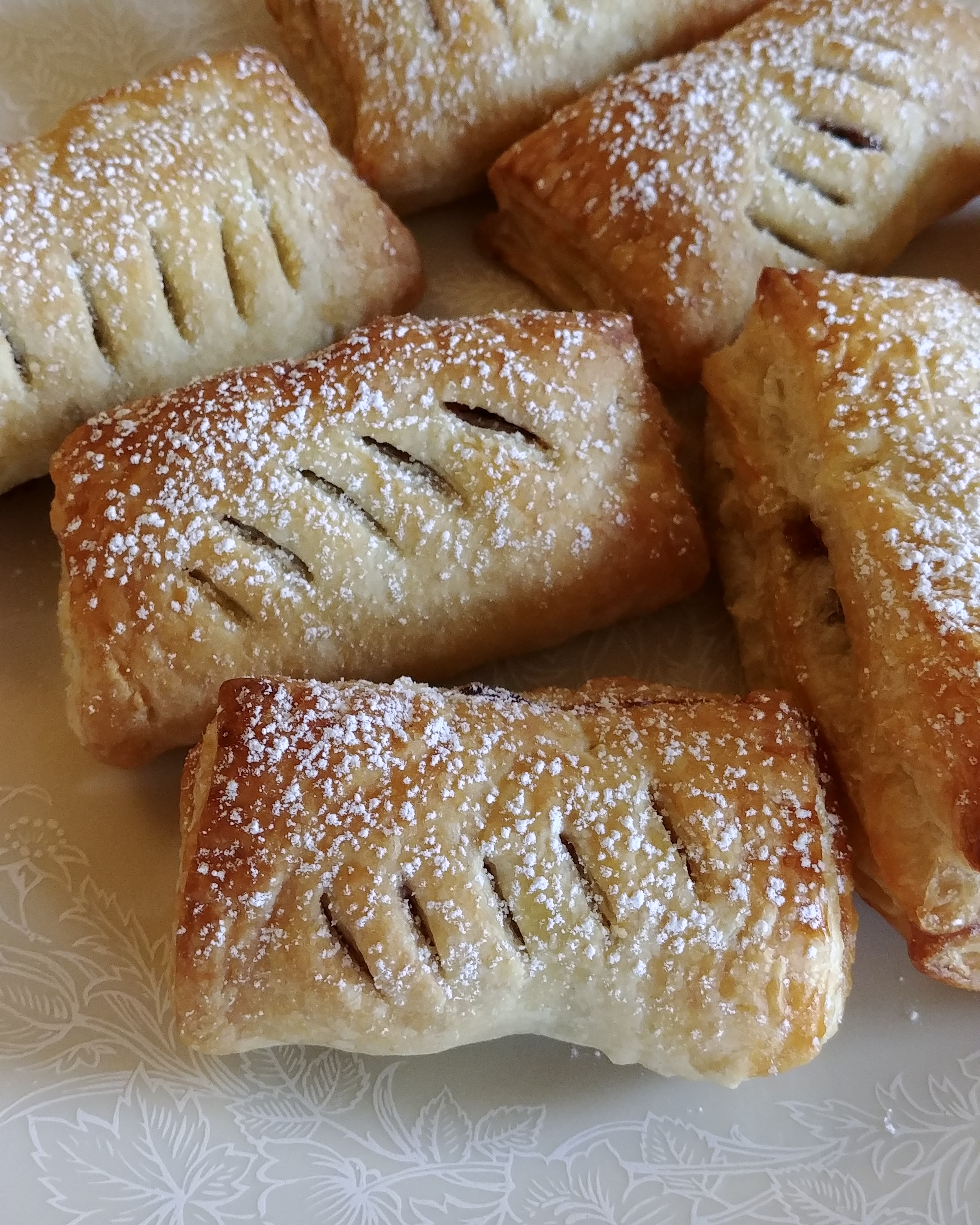
Flaky puff pastry is filled with chocolate-hazelnut spread and all-fruit raspberry spread in this delectable treat. I concocted this on a whim one afternoon, and after one bite, I knew it was one for the books! Simple, elegant, and delicious.
Provided by allison125
Categories Bread Yeast Bread Recipes
Time 38m
Yield 18
Number Of Ingredients 5
Steps:
- Preheat the oven to 400 degrees F (200 degrees C).
- Unfold the puff pastry sheets on a lightly floured surface. Cut each one into thirds along the fold lines. Roll each strip of dough out to about 16 inches long, and cut strips into thirds.
- Spread some of the hazelnut spread onto one half of each rectangle to within 1/2 inch of the edge. Spread about 1/2 teaspoon of the raspberry jam over the hazelnut spread. Brush the edges with egg, and fold over the other side to enclose the filling. Press the edges firmly to seal. Repeat with the remaining rectangles. Use a sharp knife to cut 5 slits across the top of each pastry, and place them on baking sheets, spacing 2 inches apart.
- Bake for 18 minutes in the preheated oven, or until golden brown. Cool on racks. Dust with confectioners' sugar when cooled if desired.
Nutrition Facts : Calories 189.4 calories, Carbohydrate 18.1 g, Cholesterol 10.3 mg, Fat 12 g, Fiber 0.6 g, Protein 2.6 g, SaturatedFat 2.8 g, Sodium 76.1 mg, Sugar 5.7 g
CRAB SALAD CROISSANTS
Celery and onion add crunch to the dill-seasoned crab salad that's tucked into buttery croissants from your grocery store's bakery.
Provided by Taste of Home
Categories Lunch
Time 15m
Yield 4 servings.
Number Of Ingredients 11
Steps:
- In a small bowl, combine the first nine ingredients. Serve on lettuce-lined croissants.
Nutrition Facts : Calories 502 calories, Fat 35g fat (10g saturated fat), Cholesterol 59mg cholesterol, Sodium 1004mg sodium, Carbohydrate 35g carbohydrate (2g sugars, Fiber 2g fiber), Protein 11g protein.
CREAM CHEESE FILLED CROISSANTS

My daughter wanted something cream cheese-filled for breakfast and just threw it together.
Provided by Tish
Categories Main Dish Recipes Sandwich Recipes Cheese
Time 25m
Yield 8
Number Of Ingredients 5
Steps:
- Preheat oven to 375 degrees F (190 degrees C). Grease a baking dish.
- Stir cream cheese, yogurt, and sugar together in a bowl until smooth. Fold strawberries into cheese mixture.
- Separate crescent roll dough into 8 triangles. Spoon cream cheese mixture into the middle of each triangle and roll dough around the filling, starting at the smallest end. Pinch to seal and place in the prepared baking dish.
- Bake in the preheated oven until puffed and golden-brown, 13 to 15 minutes.
Nutrition Facts : Calories 184.1 calories, Carbohydrate 17.1 g, Cholesterol 15.9 mg, Fat 11 g, Fiber 0.1 g, Protein 3.5 g, SaturatedFat 4.7 g, Sodium 266.9 mg, Sugar 7.6 g
CRAB CROISSANTS
Blue crab claw meat served on buttery croissants is a favorite picnic dish for my wife, friends and me for summer trips.
Provided by J.D.Tyre
Categories Main Dish Recipes Seafood Main Dish Recipes Crab
Time 30m
Yield 6
Number Of Ingredients 10
Steps:
- In a medium bowl, mix together the crabmeat, blue cheese dressing, mayonnaise, bread crumbs, onion, and garlic. Gently fold in tomato, and season with salt and pepper to taste. Asiago cheese can be folded into the mixture, or sprinkled over the top when serving.
- Spread about 1/2 cup of the mixture on half of each croissant, and top with the other halves.
Nutrition Facts : Calories 667.2 calories, Carbohydrate 45.5 g, Cholesterol 123.6 mg, Fat 42 g, Fiber 3.2 g, Protein 23.9 g, SaturatedFat 12.8 g, Sodium 1220.9 mg, Sugar 11.5 g
ALMOND CROISSANTS

This tender almond croissant recipe is a little lighter than others I've tried. A close friend of mine serves these every Christmas and Easter.
Provided by Taste of Home
Time 45m
Yield 16 rolls.
Number Of Ingredients 16
Steps:
- In a bowl, dissolve yeast in warm water. In a large bowl, combine the flour, sugar and salt. Cut in butter until crumbly. Add milk and egg yolks to yeast mixture; mix well. Stir into crumb mixture; mix well. Do not knead. Cover and refrigerate overnight. , Punch dough down. Turn dough onto a lightly floured surface; divide in half. Roll each piece into a 12-in. circle; cut each circle into eight wedges. In a small bowl, beat filling ingredients until smooth. Spread filling over wedges; roll up from wide end. Place with point side down 3 in. apart on ungreased baking sheets. Curve ends to form a crescent shape. Cover and let rise in a warm place for 1 hour (dough will not double). , Beat egg white and water; brush over croissants. Sprinkle with almonds. Bake at 350° for 15-20 minutes. Remove from pans to wire racks to cool.
Nutrition Facts : Calories 296 calories, Fat 16g fat (8g saturated fat), Cholesterol 72mg cholesterol, Sodium 278mg sodium, Carbohydrate 33g carbohydrate (7g sugars, Fiber 1g fiber), Protein 6g protein.
CHERRY-CHICKEN SALAD CROISSANTS
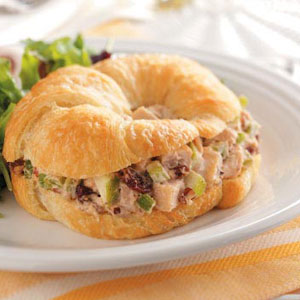
"I love cherries and happened to come across this recipe one day. It's a real hit with my family, and a friend's husband even took it to work to share with the office staff." - Martha Goodrich, Wilmington, Delaware
Provided by Taste of Home
Categories Lunch
Time 15m
Yield 7 servings.
Number Of Ingredients 10
Steps:
- In a large bowl, combine the chicken, cherries, celery, apple and pecans. In another bowl, combine the mayonnaise, buttermilk, salt and pepper; add to chicken mixture and mix well. Spoon 1/2 cup chicken salad onto each croissant.
Nutrition Facts : Calories 481 calories, Fat 30g fat (9g saturated fat), Cholesterol 71mg cholesterol, Sodium 710mg sodium, Carbohydrate 37g carbohydrate (15g sugars, Fiber 3g fiber), Protein 16g protein.
BAKED HAM 'N' CHEESE CROISSANTS
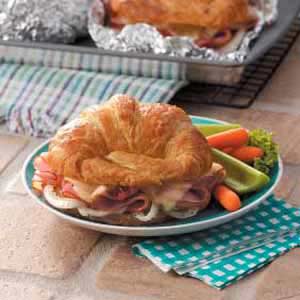
This baked ham and cheese croissant recipe is one of my favorites. It makes for a delightful brunch, lunch or light supper.
Provided by Taste of Home
Categories Lunch
Time 30m
Yield 8 servings.
Number Of Ingredients 8
Steps:
- Place onions and butter in a large microwave-safe bowl; cover and microwave on high for 2-3 minutes or until onions are tender. Stir in the mustard, poppy seeds and lemon juice. Cover and microwave on high for 1 minute or until heated through., Spread onion mixture over cut sides of croissants. On bottom halves, layer ham and cheese; replace tops. , Wrap each sandwich in foil. Place on a baking sheet. Bake at 350° for 20-25 minutes or until cheese is melted.
Nutrition Facts : Calories 595 calories, Fat 37g fat (21g saturated fat), Cholesterol 153mg cholesterol, Sodium 2262mg sodium, Carbohydrate 33g carbohydrate (6g sugars, Fiber 3g fiber), Protein 32g protein.
ACADIAN-STYLE CRAB SALAD ON CROISSANTS

Provided by Rachael Ray : Food Network
Time 12m
Yield 12 pieces, 6 servings
Number Of Ingredients 10
Steps:
- Run your fingers through the crab meat to remove any bits of shell. In a bowl, combine the celery, onion, mayo, chili, hot sauce and Worcestershire. Add the crab meat to the bowl and mix with a fork. Season with salt and pepper, to your taste. Pile salad on lettuce leaves in croissants. Cut each croissant in thirds on angles, following the shape of the pastry. Arrange sandwiches on a plate and serve.
HAM AND CHEESE CROISSANTS

The amount of ham and cheese inside these croissants might seem a tad skimpy, but resist the urge to add more. The extra moisture from the filling can make the interior soggy and affect how the dough rises, so rest assured it's more than enough to flavor these savory pastries. (Make sure your first attempt at croissants is a successful one, with these tips, and Claire Saffitz's step-by-step video on YouTube.)
Provided by Claire Saffitz
Categories pastries, project
Time 4h
Yield 10 croissants
Number Of Ingredients 6
Steps:
- Arrange racks in the upper third and lower thirds of the oven. Bring a skillet of water to a simmer over medium-high heat. Transfer the skillet to the floor of the oven and close the door. (The steam released inside the oven will create an ideal proofing environment for the pastries.) Line two rimmed baking sheets with parchment paper and set aside.
- Let the dough sit for 5 minutes at room temperature. Unwrap (save the plastic wrap for proofing) and place on a very lightly floured surface. If the dough has shrunk during chilling, roll it out again to a slab that's 16 inches long and 15 inches wide. Dust off any excess flour.
- Use a wheel cutter to trim 1/2 inch of dough from all four sides, straightening and squaring them off, creating a slab that's 15 inches long by 14 inches wide. Using a ruler, cut the slab lengthwise into 5 equal strips each measuring 3 inches wide. Cut each strip in half crosswise, creating 10 rectangles.
- Working with one rectangle of dough at a time, cover one half with a slice of ham, folding it as needed to leave a 1/2-inch border along the short side. Then, top with 1/2 ounce (2 tablespoons) of the cheese. Roll the dough into a snug spiral, starting at the end with the ham and cheese, then transfer the spiral to one of the prepared baking sheets, resting it on the seam. Repeat with the remaining dough, ham and cheese, dividing between the sheets and spacing evenly. Very loosely cover with plastic wrap so the pastries have some room to expand.
- Open the oven and stick your hand inside: It should be humid but not hot, as the water in the skillet will have cooled. You want the pastries to proof at 70 to 75 degrees (any hotter and the butter will melt, leading to a denser pastry). Gently place the baking sheets inside the oven on the two racks and let the pastries proof until they're doubled in size, extremely puffy and jiggle delicately on the baking sheet, 2 to 2 1/2 hours.
- When the pastries are proofed, remove the baking sheets from the oven and carefully uncover them. Transfer to the refrigerator and chill for 20 minutes while you heat the oven. Remove the skillet from the oven and heat to 375 degrees.
- In a small bowl, stir the yolks and heavy cream until streak-free. Remove the baking sheets from the refrigerator and use a pastry brush to gently brush the surfaces of each pastry with the yolk mixture. Transfer the sheets to the oven and bake for 20 minutes. Rotate the baking sheets and switch racks and continue to bake until the pastries are deeply browned, another 10 to 15 minutes. Remove from the oven and let cool completely on the baking sheets.
ALMOND CROISSANTS

Rum simple syrup and toasted almond cream - both quick and easy to assemble - are all you need to transform stale homemade or store-bought croissants into deliciously sweet and fragrant pastries. The amount of syrup might feel excessive, but it's needed to replace the moisture lost in the croissants as they become stale, so be generous when soaking them.
Provided by Claire Saffitz
Categories breakfast, brunch, pastries, project
Time 1h
Yield 8 croissants
Number Of Ingredients 11
Steps:
- Make the frangipane: Place the almond flour in a medium skillet and set over medium heat. Cook, stirring frequently, until golden brown and toasty smelling, 5 to 8 minutes. Remove from heat and set aside to cool.
- In a medium bowl, combine the butter and brown sugar, and beat with a silicone spatula or wooden spoon until the mixture is light and creamy, about 2 minutes. Switch to a whisk and whisk in the eggs, one at a time, until incorporated. Whisk in the almond extract, then add the flour, salt and toasted almond flour, and whisk until smooth and satiny. Set the mixture aside.
- Make the syrup: In a small saucepan, combine the sugar, rum and 1/3 cup/80 milliliters water in a small saucepan and heat over medium, stirring just until the sugar dissolves. Remove from the heat and set aside.
- Assemble: Arrange a rack in the upper third of the oven and heat to 350 degrees. Line a large rimmed baking sheet with parchment paper and set aside.
- Use a pastry brush to soak the cut sides of the croissant halves liberally with the rum syrup. (Use most of it or all, if the croissants are very stale.) Spread the bottom halves with half of the frangipane, dividing evenly and spreading all the way to the edges. Place the top halves over the bottom halves, then spread the remaining frangipane over the tops of the croissants. Sprinkle the sliced almonds over top, dividing evenly.
- Place the croissants on the baking sheet, spacing evenly, and bake until the almonds are toasted and the frangipane is golden brown, 20 to 25 minutes. Serve warm or at room temperature.
Tips:
- Use high-quality ingredients: The better the ingredients, the better the croissants will be. Use unsalted butter, bread flour, and active dry yeast.
- Keep the butter cold: The butter should be cold when you add it to the dough. This will help to create flaky layers.
- Work quickly: The dough should be worked as little as possible. Overworking the dough will make it tough.
- Let the dough rise in a warm place: The dough should rise in a warm place until it has doubled in size. This will take about 1-2 hours.
- Bake the croissants at a high temperature: The croissants should be baked at a high temperature (400°F) for 15-20 minutes. This will help to create a golden brown crust.
Conclusion:
Croissants are a delicious and flaky pastry that can be enjoyed for breakfast, lunch, or dinner. They are a bit time-consuming to make, but they are definitely worth the effort. With a little practice, you can make perfect croissants at home. Experiment with different fillings and toppings to find your favorite way to enjoy them.
Are you curently on diet or you just want to control your food's nutritions, ingredients? We will help you find recipes by cooking method, nutrition, ingredients...
Check it out »
#weeknight #time-to-make #course #preparation #breads #dietary #low-sodium #yeast #low-in-something #number-of-servings
You'll also love





